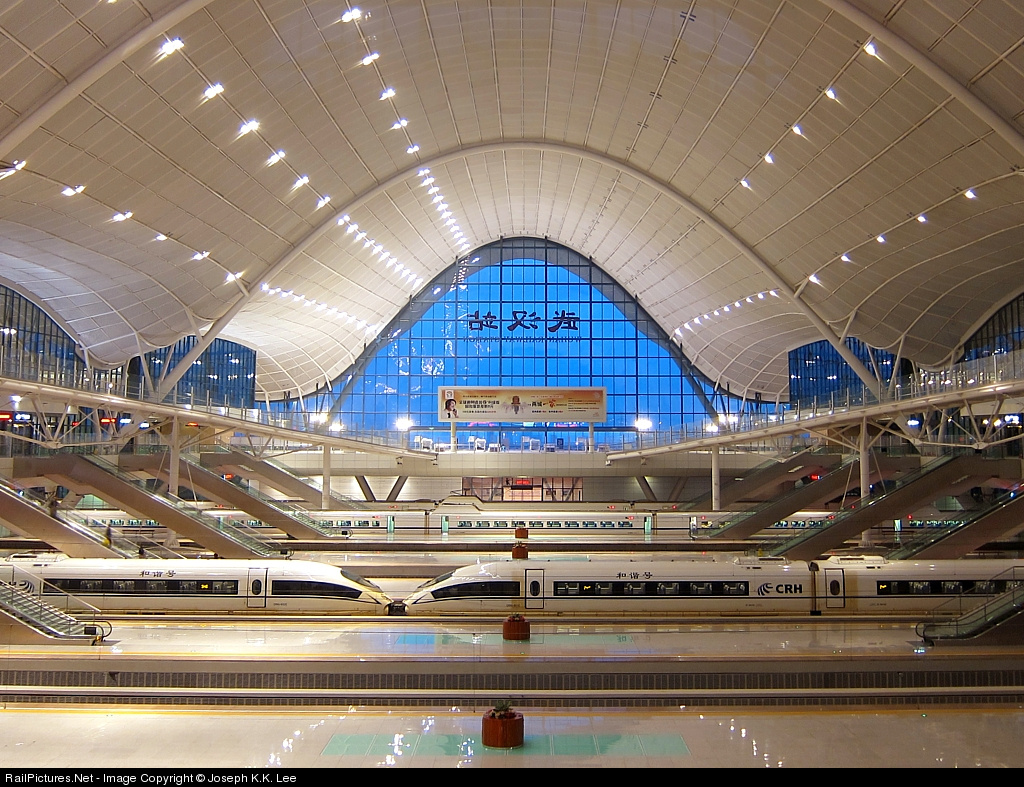China's Nationwide High Speed Rail Network: Now or Never
Wuhan Station with CRH3C in the foreground and CRH2C in the background
Travellers board a high-speed train which heads to Guangzhou in Wuhan, Hubei province
"Comparing Long-Distance High-Speed Rail Routes
Line---------------------------- Distance Travel Time
Avg Speed
China: Wuhan-Guangzhou.. 968 km... 2h57........
328 km/h
Spain: Cordoba-Barcelona.. 966 km.... 4h42....... 206 km/h
France: Lille-Marseille......... 959 km.... 4h40....... 206 km/h
Italy: Turin-Naples............. 900 km.... 5h45....... 157 km/h
USA: Boston-Newport News 1034 km 12h35......... 82 km/h
Published: 28-Dec-2009"
The article "China's Fast Track to Development" provides important insights into China's motivation for building a nationwide high-speed rail system. For your convenience, I have itemized the main reasons. (See
)
1) "Moving passenger traffic off clogged conventional rail lines will free up room for an explosion of freight traffic."
2) "Increased freight revenue will pay the capital cost of building the new lines."
3) "By reducing the need for airplanes, cars and trucks to carry passengers and freight, the system will yield big savings in energy intensity and carbon emissions."
"
Respected transportation economists Richard Gilbert and Anthony Perl reported that electrified high-speed trains traveling on their own right of way are about 9 times more energy-efficient per passenger mile than private automobiles or domestic jet travel (and hence emit about one-ninth as much pollution as air and auto)." See
4) "Over the next decade, China's Ministry of Railways expects
freight carriage to rise 55%, while
passenger-miles will double. More miles of track are not a luxury, but
a necessity. In addition to the high-speed lines, the ministry plans to lay another 18,000 kilometers of new conventional freight and passenger track by 2020."
5) "In France, Spain or Japan a mile of high-speed track costs triple a conventional mile.
But in China, according to World Bank estimates, the cost premium is as low as 20% to 30%. Cheap labor and
locally produced equipment help; so does the decision to
build much of the network on viaducts, minimizing land acquisition cost. Finally,
building an entire network all at once produces massive economies of scale."
6) "This modest cost premium translates into
affordable ticket prices—higher than for conventional rail, but lower than for air travel. The
average household income in China's 36 biggest cities is now more than $10,000, so
tens of millions of Chinese can easily afford high-speed tickets, especially for business trips."
7) "
On several recent trips on the Nanjing-Wuhan, Wuhan-Guangzhou and Guangzhou-Shenzhen lines, we found the trains to be about 90% full. The World Bank reckons that in a few years' time the Beijing-Hong Kong line will carry more than 80 million passengers a year, becoming the world's busiest high-speed passenger rail line."
8) "But the
really big gain is that by moving most passenger traffic off existing conventional lines, more space is freed up for cargo. China's businesses—ranging from manufacturers to coal mines—have complained for years about the difficulty of securing space on freight trains, which forces them to move a lot of their cargo on more expensive and less efficient trucks. An increase in rail capacity will enable them to put their freight back on trains, generating huge savings.
Ton for ton, freight carried by rail costs nearly 70% less than carriage by truck, uses 77% less energy and produces 91% less carbon dioxide emissions."
9) "For one thing,
building the network now, when labor costs are still low, is smarter than waiting a decade or two, when higher wages will push the real cost far higher." In my opinion, China has to build a nationwide high-speed rail network now. I don't think labor construction costs will be affordable in another ten to twenty years. Payment for labor is increasing rapidly in China. By the way, Foxconn (e.g. a Taiwanese company) has 800,000 employees in China.
"* JUNE 2, 2010, 8:20 P.M. ET
Foxconn: Production Line Workers In China Get
30% Pay Rise"
"Honda says Chinese labor dispute has been settled
By CARA ANNA (AP) – 9 hours ago
BEIJING —
Honda Motor Co. said a labor dispute at a parts plant that crippled the automaker's production in China has been resolved after a
wage increase of 24 percent, and the affected assembly plants would be running again Saturday."
"Beijing to Raise Minimum Wage
By REUTERS
Published: June 3, 2010
BEIJING (Reuters) —
Beijing will increase the city’s minimum wage by 20 percent, state media reported on Thursday, the latest sign of rising labor costs in the world’s third-largest economy."




